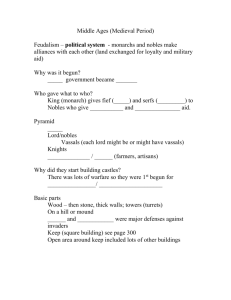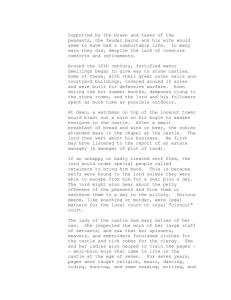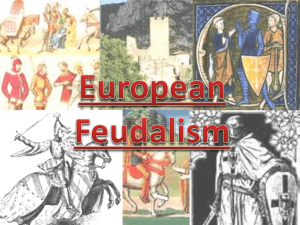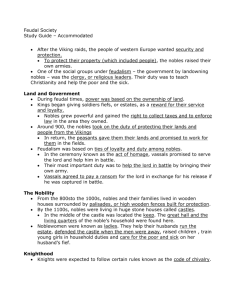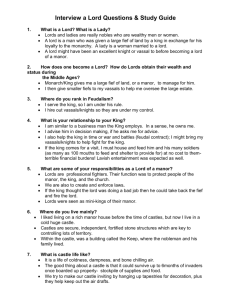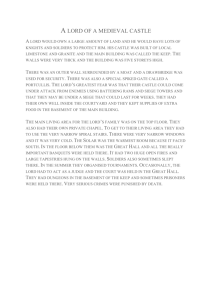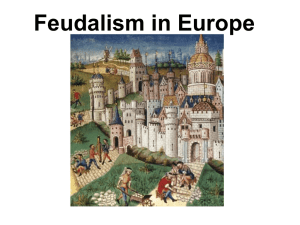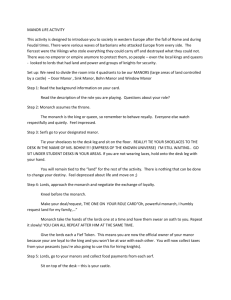FEUDAL SOCIETY AND ITS ORIGIN Medieval times (also called the
advertisement
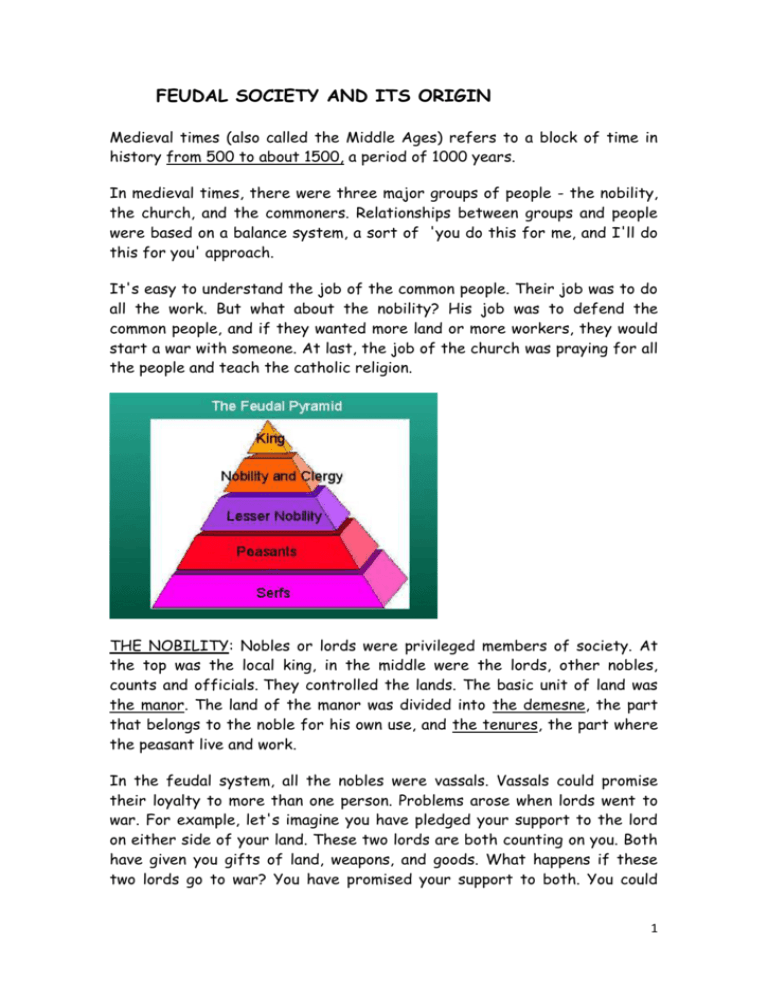
FEUDAL SOCIETY AND ITS ORIGIN Medieval times (also called the Middle Ages) refers to a block of time in history from 500 to about 1500, a period of 1000 years. In medieval times, there were three major groups of people - the nobility, the church, and the commoners. Relationships between groups and people were based on a balance system, a sort of 'you do this for me, and I'll do this for you' approach. It's easy to understand the job of the common people. Their job was to do all the work. But what about the nobility? His job was to defend the common people, and if they wanted more land or more workers, they would start a war with someone. At last, the job of the church was praying for all the people and teach the catholic religion. THE NOBILITY: Nobles or lords were privileged members of society. At the top was the local king, in the middle were the lords, other nobles, counts and officials. They controlled the lands. The basic unit of land was the manor. The land of the manor was divided into the demesne, the part that belongs to the noble for his own use, and the tenures, the part where the peasant live and work. In the feudal system, all the nobles were vassals. Vassals could promise their loyalty to more than one person. Problems arose when lords went to war. For example, let's imagine you have pledged your support to the lord on either side of your land. These two lords are both counting on you. Both have given you gifts of land, weapons, and goods. What happens if these two lords go to war? You have promised your support to both. You could 1 find yourself quite literally in the middle, and you would lose no matter who won. It was critical for everyone's survival that the lord had strong vassals. The peasants were not armed. They had no defense. They had to count on the lord of the manor to protect them. The lord had to count on his vassals. Everything circled around violence - preparing, defending, recovering from battle. The people were terrified and exhausted. THE CHURCH OR THE CLERGY: The group that lived the most comfortable life during the Middle Ages was the clergy. At the top of the power were the Pope, but in a local monastery the abbots, bishops and cardinals were the power. There were only a few cardinals, and only one pope. The cardinals served the pope, and the pope served God. Most abbots, bishops and cardinals came from noble families. They received land from kings in exchange for military service. But they could not fight. They were religious leaders. They gave some of their land to knights to fight in their place. In exchange for the land, the knights pledged themselves as vassals of the bishops and abbots. That meant abbots and bishops could easily have men to fight. The church received donations of land, jewelry, and money from nobles as acts of penance. Nobles paid the church to educate their children. Everyone paid the church for various sacraments. People believed that the only way to get to Heaven was to follow the teachings in the Bible. The common people could not read or write. The village priest read to them from the Bible and told them how to behave. 2 The priest told them who they must marry and when. You had to do everything the priest said if you wanted to get to heaven. THE COMMONERS: The common people were peasants, and serfs. There was a difference between them: Serfs belong to the fief. They were not slaves. These people could not be bought and sold. Serfs could not leave the manor without permission. If they did not work, they were punished. If the manor land was sold or reassigned to a new owner, the serfs stayed with the land. Serfs had many jobs on the manor including craftsmen, bakers, farmers, and tax collectors. Their job was assigned. They had to do the job they were assigned to do. Peasants were free to leave if they wished, but where would they go? War was everywhere. Peasants worked the land and made the goods in exchange for protection, but most of them had got the same life just like a serf's life. A few peasants escaped the hard work on the farm by joining the church. But most lived and died on the manor where they were born. The commoners had to pay taxes to the lord, to the king and to the church. They had to pay for everything: To pay the crop tax, to the lord, to pay the bread tax to the lord, to pay the bridge tax to the lord, to pay the water tax to the lord... All peasants had to set aside a certain number of days 3 each year to work on the roads or on the lord's home or on whatever else needed doing. REMEMBER YOUR KNOWLEDGE: 4 ACTIVITIES 1. Match each word with its definition: 1. a. Feudalism. b. Vassal. c. The manor. d. Demesne. e. Tenures. f. Serf. Manor lands reserved for the nobles and lords. 2. Manor lands granted to the peasant by the lord. 3. Person who below to a manor and works for the lord. 4. Social system based on relationships between lords and vassal. 5. Group of lands of a noble or lord. 6. Person who swears fidelity to a lord. 2. Complete the feudal society pyramid with the following words: peasant, nobles, clergy, king. 3. Read the following information and complete the review. 5 Feudal Contract LORDS GIVE SERVICE TO GIVE PROTECTION TO VASSALS 10 CONSTRUCTING THE PYRAMID OF POWER KING LOYALTY AND SERVICE LAND POWERFUL NOBLES LAND AND PROTECTION LOYALTY AND MILITARY SERVICE LESSER NOBLES (KNIGHTS) LABOR PROTECTION SERFS AND FREEMEN 15 6 REVIEW Let’s see how much you remember! 1) 2) 3) 4) 5) Everyone owed loyalty to the ________ _______ were really the most powerful. They got _______ from the king. Lesser nobles (knights) gave _________ _________ in return for land _______ were bound to the land. They worked in return for ____________. __________ were skilled workers. They paid rent to the ______ and were free to move if they wanted to. 16 Check Your Answers 1) 2) 3) 4) 5) Everyone owed loyalty to the king. Nobles were really the most powerful. They got land from the king. Lesser nobles (knights) gave military service in return for land. Serfs were bound to the land. They worked in return for protection. Freemen were skilled workers. They paid rent to the nobles and were free to move if they wanted to. 17 4. Match each character with a concept and make a sentence. 7 Monastery Serf Fief THE FIEF As you know, land in medieval times was broken up into fiefs. A fief was a trust, rather than an ownership. Your oldest son could inherit the fief, but you could not sell a fief in early medieval times. A fief meant more than land. Each fief was a complete unit. That unit included at least one village, houses for the serfs, the manor house or castle, and areas set aside to grow, feed, or catch food - the fields, pasture land, and woods. The only outsiders allowed to live on a fief were peasants. Peasants were freemen. They could come and go as they wished, but where would they go? War was everywhere. Peasants received protection and the use of a small piece of land on which to build a home in exchange for work. The serfs stayed with the land. They were part of the fief. Their job was to do all the work. In exchange, the serfs would receive food and protection. Although fiefs were given to military men as rewards, fiefs came with certain obligations, obligations beyond feeding and protecting the fief workers, the serfs. In exchange for ownership of a fief, you had to promise certain things. 8 You had to promise loyalty to the king or to the lord who gave you the fief. You had to provide military service. You did not have to fight yourself, but you had to send men when needed. You had to act as a host when your king or lord came visiting. You had to contribute funds for a ransom if your king or lord was captured in battle. You had to provide gifts of cash to help offset the costs of any of your lord's special occasions, such as a wedding. 5. See the presentation power point about the fief and describe it. THE CASTLES OF THE MIDLE EDGE In medieval society, noblemen and Knights lived in castle. They lived with servants, soldiers and craftsmen. Animals also lived inside the castle. Big castles had gardens and a church. The knights protected the peasant that lived in the villages near the castle. The peasants worked and produced food for the people in the castle and were very poor. Originally, castles were made of wood, but by the 11th century most castle were made of stone. There were big walls around the castle and usually there was a moat filled with water to protect the castle from attack. A drawbridge over the moat was the entrance to the castle. All the rooms were located around a big patio. Soldiers lived in towels located in the castle wall, and the lord and his family lived in the biggest and more protected towel, named donjon. There were other buildings like a building for animal, a little church, a smithy and a little market. 9 http://www.abdn.ac.uk/english/lion/castles.shtml Life in the castle was boring because many of the people rarely went outside the castle wall. However, the lord frequently celebrated parties with music and tournaments are also held. 10 ACTIVITIES 1. See the diagram of about the medieval castle and links each concept with the correct definition: -The main towel where the lord Buildings for animals. lived with his family. It was the most protected part of the castle. Barbican. -The wall that surrounding the castle . Outer Bailey. -The place where the animals live. -Part of the gatehouse where Donjon. the soldiers defended the castle and live there. 2. Look for the meaning of these word and write a sentence with each one: Tournaments: Troubadour: 11 Jugglers: BIBLIOGRAFY This unit has been elaborate with the following resources http://www.medievaleurope.mrdonn.org/ http://www.medievalresources.com/Feudal.html http://www.mce.k12tn.net/middleages/feudalpyramid.gif http://www.learner.org/interactives/middleages/ Cross-Curricular material for ESO. Burlington Books, Social sciences. Colección de recursos multimedia de Ciencias Sociales 2º ESO de Oxford educación. 12
